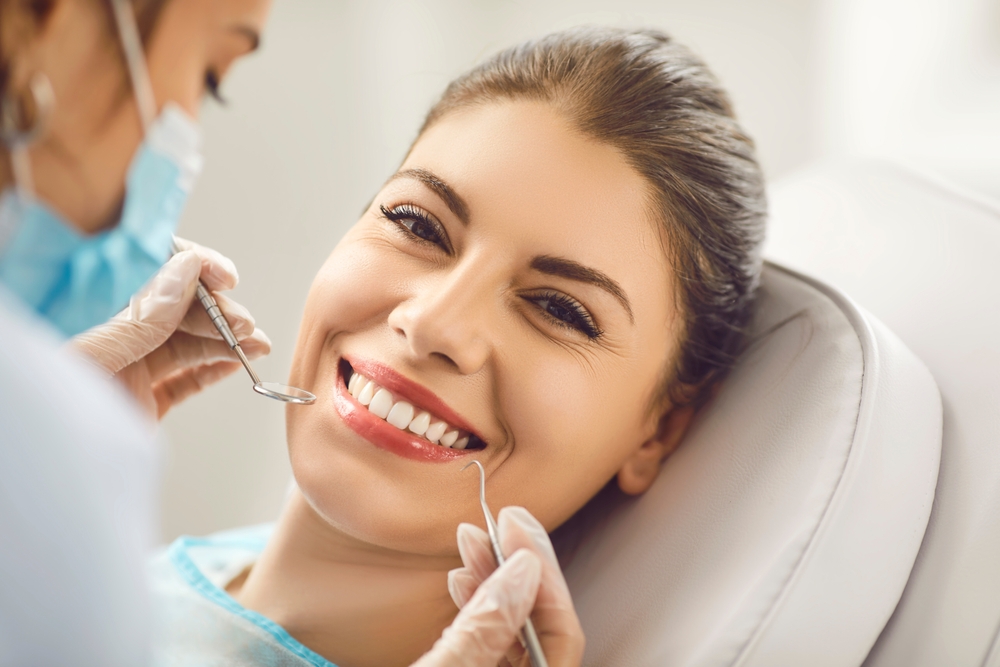 A bright, white smile is often seen as a sign of health and confidence, which is why teeth whitening has become one of the most popular cosmetic dental treatments. But with so many products and procedures available, it’s natural to wonder: Can teeth whitening ruin your teeth? At Riverside Dental, we want to provide you with the facts, explore the risks, and offer alternative options for a safe and effective whitening experience, especially for residents in desert climates like St. George, UT.
A bright, white smile is often seen as a sign of health and confidence, which is why teeth whitening has become one of the most popular cosmetic dental treatments. But with so many products and procedures available, it’s natural to wonder: Can teeth whitening ruin your teeth? At Riverside Dental, we want to provide you with the facts, explore the risks, and offer alternative options for a safe and effective whitening experience, especially for residents in desert climates like St. George, UT.
The Science Behind Teeth Whitening
Teeth whitening involves the use of bleaching agents, typically hydrogen peroxide or carbamide peroxide, to remove stains and discoloration from the tooth surface. These bleaching agents work by penetrating the enamel (the outermost layer of your teeth) and breaking down the pigmented compounds that cause stains.
Over time, teeth naturally accumulate stains from foods, beverages, and lifestyle habits. Common culprits include coffee, tea, red wine, and tobacco. Teeth whitening treatments are designed to target these stains, restoring the natural whiteness of your teeth.
Can Teeth Whitening Damage Your Teeth?
When done correctly and under professional supervision, teeth whitening is generally safe and effective. However, improper use or overuse of whitening products can lead to several issues:
1. Enamel Damage
The enamel is the protective outer layer of your teeth. Overusing whitening agents, particularly high-concentration products, can weaken the enamel, making your teeth more sensitive to temperature changes and prone to decay. While enamel cannot be restored once it’s lost, you can take steps to protect it by following professional advice and using products approved by dental professionals.
Statistic: According to the American Dental Association (ADA), over 40% of people who use at-home whitening kits report tooth sensitivity, and enamel erosion is a common risk associated with unsupervised or over-the-counter treatments.
2. Increased Tooth Sensitivity
One of the most common side effects of teeth whitening is tooth sensitivity. When bleaching agents penetrate the enamel, they can irritate the nerves within your teeth, leading to discomfort when consuming hot or cold foods and drinks. For individuals already dealing with sensitivity, this can be particularly problematic.
In desert climates like St. George, where dry air and temperature fluctuations are common, increased sensitivity can be even more noticeable. The lack of humidity in the air can exacerbate dryness in the mouth, further contributing to discomfort when sensitive teeth are exposed to temperature extremes.
3. Gum Irritation
Some teeth whitening products, especially those that involve high concentrations of bleaching agents, can irritate the gums. If the whitening solution comes into contact with your gum tissue, it may cause redness, swelling, or even a burning sensation. This is why it’s important to apply whitening treatments carefully, ensuring they only come into contact with your teeth. Professional supervision is essential to minimize this risk.
How to Whiten Your Teeth Safely
To avoid the risks associated with improper teeth whitening, it’s essential to follow safe practices. Here are some guidelines:
1. Opt for Professional Whitening Services
The safest and most effective way to whiten your teeth is through professional treatments at a dental office. At Riverside Dental, we offer in-office teeth whitening treatments that are monitored by our dental professionals. Our treatments use controlled amounts of whitening agents to minimize the risk of sensitivity and damage, ensuring you achieve the desired results safely.
Statistic: Research shows that professional teeth whitening treatments can brighten teeth by up to 10 shades in just one session, offering a safer and more effective solution compared to over-the-counter products.
2. Use ADA-Approved Whitening Products
If you prefer whitening your teeth at home, make sure to choose products with the ADA Seal of Approval. These products have been tested for safety and efficacy, ensuring they contain the appropriate concentration of bleaching agents for home use. Following the instructions on these products carefully is crucial to avoid overuse and potential enamel damage.
3. Limit the Frequency of Whitening Treatments
Whitening treatments should not be used excessively. Over-whitening your teeth can lead to permanent enamel damage and increase the risk of tooth sensitivity. Most professionals recommend spacing out whitening treatments and avoiding more than a few sessions per year to maintain the health of your teeth.
Alternative Options for Whitening Teeth
If you’re concerned about the risks associated with traditional whitening methods or if you have sensitive teeth, there are alternative options available:
1. Whitening Toothpaste
Whitening toothpaste contains mild abrasives that help remove surface stains. While it doesn’t offer the same dramatic results as professional treatments, it’s a safer option for maintaining a bright smile between whitening sessions. It’s especially useful for individuals with mild discoloration or those looking to maintain results after a professional whitening treatment.
2. Whitening Strips
Over-the-counter whitening strips can be effective when used correctly, but it’s important to choose products that have the ADA Seal of Approval. These strips are generally less concentrated than professional treatments, making them a safer option for home use. However, individuals in dry climates should ensure they maintain proper oral hygiene and hydration to minimize sensitivity.
3. Natural Remedies
Some natural remedies, like using baking soda or oil pulling, can help remove surface stains. While these methods are generally safe, they don’t offer the dramatic results of professional whitening. Baking soda, for instance, can gently scrub the surface of your teeth, but it should be used sparingly as excessive use can be abrasive.
Local Insight: Living in a desert climate like St. George means you’re more susceptible to dry mouth, which can impact your oral health and tooth coloration. Drinking plenty of water and staying hydrated is a natural way to keep your teeth healthy and reduce surface stains caused by food particles and bacteria buildup.
Tips for Maintaining White Teeth in a Desert Climate
Desert climates present unique challenges for maintaining a bright smile. Here are some tips to keep your teeth looking their best:
- Stay Hydrated: Drinking water helps wash away food particles and bacteria, reducing the chances of staining and decay. It also keeps your mouth moist, which is essential for maintaining healthy enamel.
- Use a Humidifier: Dry air can affect your oral health, leading to dry mouth and increased sensitivity. Using a humidifier at night can help maintain moisture levels and support a healthier oral environment.
- Protect Your Teeth from Stain-Causing Foods: Limit your intake of coffee, tea, red wine, and acidic foods. If you do consume these, rinse your mouth with water afterward or brush your teeth to minimize staining effects.
Protect Your Smile with Professional Whitening at Riverside Dental
While teeth whitening can enhance your smile and boost your confidence, it’s important to approach it with caution to avoid potential risks like enamel damage and increased sensitivity. At Riverside Dental, we offer safe and effective professional whitening services tailored to your needs and the unique conditions of St. George’s desert climate.
Are you ready for a brighter smile? Schedule your professional teeth whitening appointment today by calling Riverside Dental at (435) 673-3363 or visiting our website to book online. Let our team of experts help you achieve a radiant, healthy smile—safely and effectively!



Leave a Reply